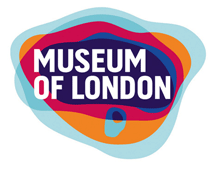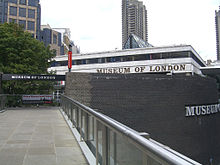Museum of London
 |
|
 |
|
| Established | 1976 |
|---|---|
| Location |
London Wall London, EC2 United Kingdom |
| Director | Sharon Ament |
| Public transit access | Barbican; St. Paul's |
| Website | museumoflondon.org.uk |
The Museum of London documents the history of London from prehistoric to modern times. The museum is located on London Wall, close to the Barbican Centre as part of the striking Barbican complex of buildings created in the 1960s and 1970s as an innovative approach to re-development within a bomb-damaged area of the City of London.
It is a few minutes' walk north of St Paul's Cathedral, overlooking the remains of the Roman city wall and on the edge of the oldest part of London, now its main financial district. It is primarily concerned with the social history of London and its inhabitants throughout time. The museum is jointly controlled and funded by the City of London Corporation and the Greater London Authority.
The museum is the largest urban history collection in the world, with more than six million objects. It hosts more than one million visitors each year.
In March 2015, the museum announced plans to move from its Barbican site to nearby Smithfield Market. The move, contingent upon raising an estimated £70 million, is planned to be complete by 2021.
The amalgamation of the collections previously held by the City Corporation at the Guildhall Museum and of the London Museum, which was located in Kensington Palace, was agreed in 1964. The Museum of London Act, allowing for the merger, was passed in the following year.
The museum was opened in December 1976 as part of the Barbican Estate, The architects were Philip Powell and Hidalgo Moya, who adopted an innovative approach to museum design, whereby the galleries were laid out so that there was only one route through the museum – from the prehistoric period to the modern galleries.
The museum comprises a series of chronological galleries containing original artefacts, models, pictures and diagrams, with a strong emphasis on archaeological discoveries, the built city, urban development and London's social and cultural life, with interactive displays and activities for all ages. Fragments of the Roman London Wall can be seen just outside the museum. The prehistoric gallery, "London Before London" and the "Medieval London" gallery have already been updated, and in 2010 a refurbished gallery on "War, Plague and Fire" opened, covering the period of the English Civil War and the Great Fire of London.
...
Wikipedia
